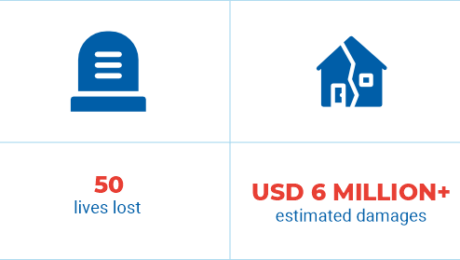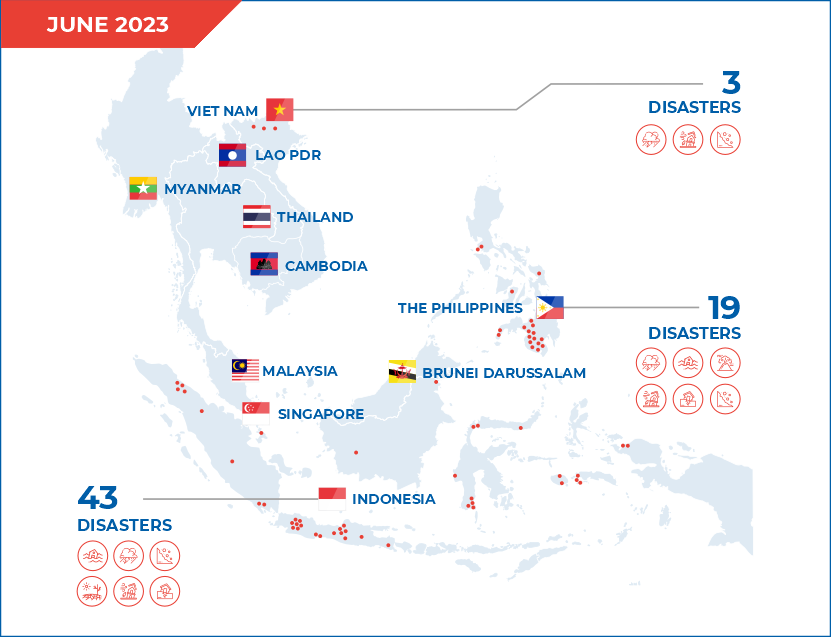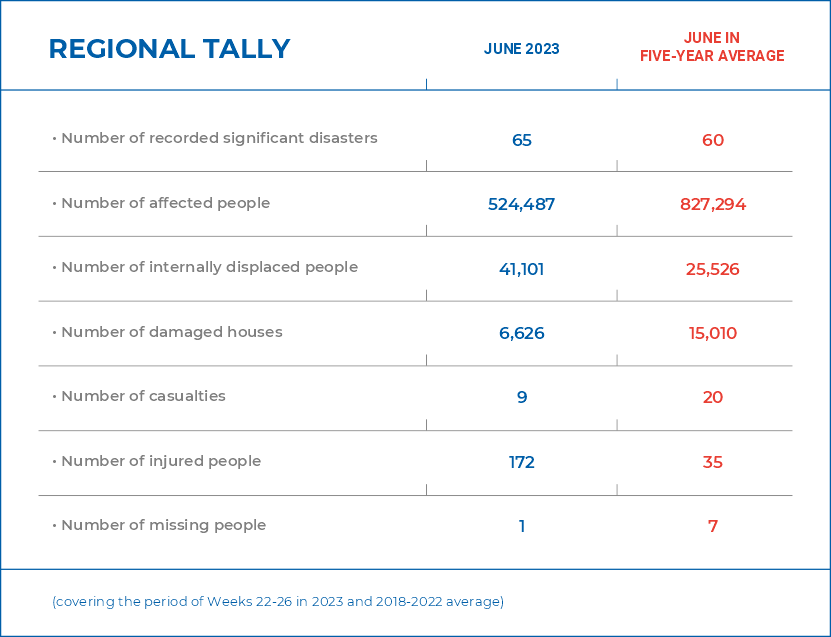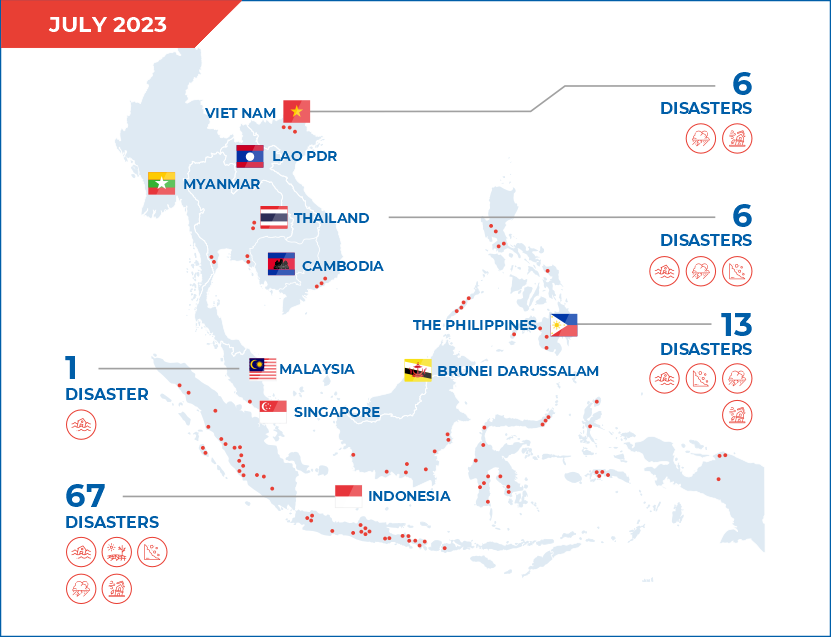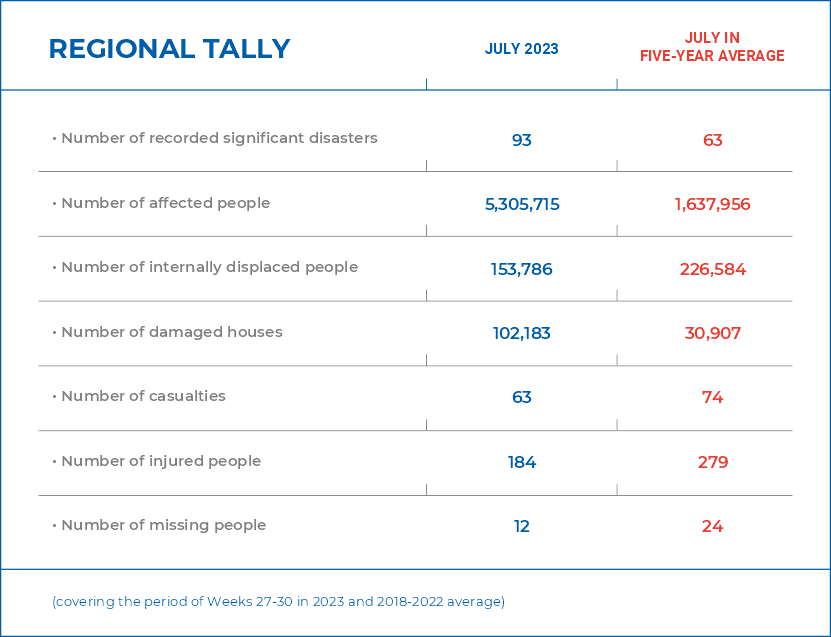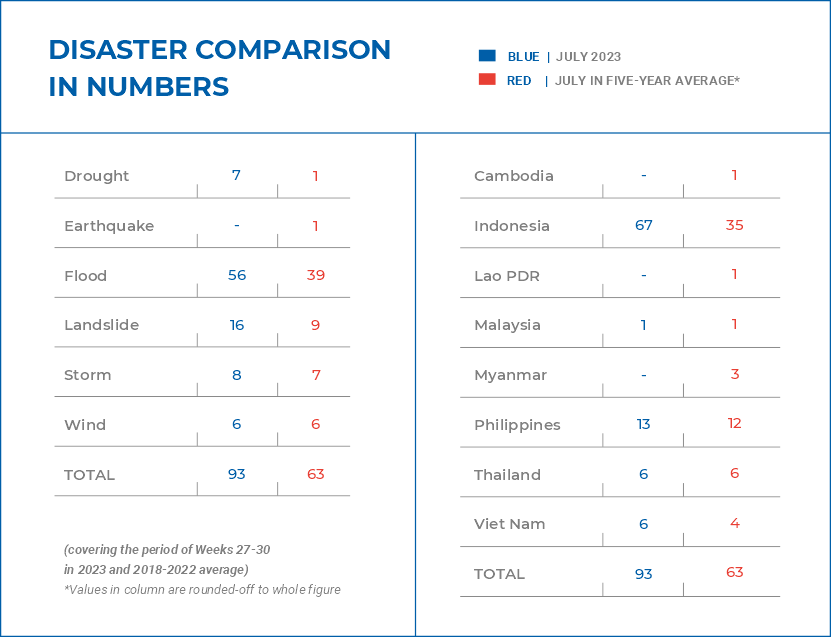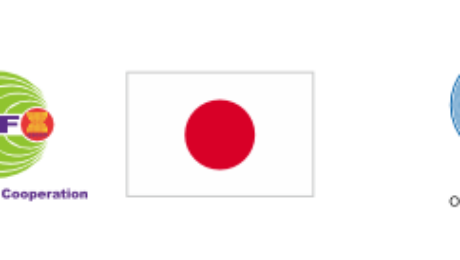Vol 85 – REMEMBERING TYPHOON MANGKHUT (OMPONG)

REMEMBERING TYPHOON
MANGKHUT (OMPONG)
On 15 September, Typhoon Mangkhut (locally known as Ompong) made landfall in Cagayan Province, the Philippines, unleashing devastating winds and torrential rains. In its wake, over 2.5 million people were affected, 50 lives lost, and hundreds injured. Homes, infrastructure, and livelihoods across eight provinces and seven cities/municipalities were severely affected. Typhoon Mangkhut, with a diameter surpassing that of 2013’s Typhoon Haiyan, caused damages estimated at over USD 6 million.
Pre-emptive actions by the Government of the Philippines, such as early evacuations and the provision of essential supplies played a large part in reducing the number of casualties and mitigating the disaster’s impact. The AHA Centre’s involvement was also instrumental, both in the preparation for and response to Typhoon Mangkhut. Working closely with the Philippines’ National Disaster Risk Reduction and Management Council (NDRRMC), the AHA Centre tracked the typhoon’s progress as it moved towards the Philippines.
An In-Country Liaison Team (ICLT) arrived in the Philippines hours after the typhoon’s landfall, standing by at the Emergency Operations Centre (EOC) of the NDRRMC to provide support to national relief efforts. Three ASEAN Emergency Response and Assessment Team (ASEAN-ERAT) Information Management Specialists were also deployed to support the NDRRMC with data analysis, data visualisation, and report writing.
The AHA Centre mobilised relief items worth over USD 275,000, including 30 tonnes of rice, four generator sets, and 2,000 rolls of tarpaulins, which were formally handed over to the NDRRMC in a meeting on 24 September 2018.
Five years later, the ASEAN response to Typhoon Mangkhut reminds us of the importance of preparedness, resilience, and unity in the face of calamities. ASEAN’s unified approach stands testament to the collective strength and solidarity of the ASEAN Member States in the spirit of “One ASEAN One Response.”

Written by: Gladys Respati | Photos by: AHA Centre
- Published in Insight
Vol 85 – MONTHLY DISASTER REVIEW AND OUTLOOK

MONTHLY DISASTER REVIEW AND OUTLOOK
SEPTEMBER 2023 | DISASTER MONITORING & ANALYSIS
(DMA) UNIT, AHA CENTRE
GENERAL REVIEW OF SEPTEMBER 2023
For the month of September 2023, a total of 111 disasters were reported. The number of reported occurrences was 42.49% less than the number of reported disasters in September of the last year. The ASEAN Member States affected for September 2023 were Cambodia, Indonesia, Myanmar, Philippines, Thailand, and Viet Nam. Most of the disasters (54.95%) occurred in Indonesia and accounted for 43.6% of the affected persons (around 670K persons), the highest number of affected persons for this reporting period. The share of the disaster-affected people for the other ASEAN Member States are as follows: (1) Indonesia – 43.62%, (2) Philippines – 28.07%, (3) Thailand – 14.16%, (4) Cambodia – 13.13%, (5) Viet Nam – 0.42%, (6) Myanmar – 0.39%, and (7) Malaysia – 0.21%. September 2023 saw disasters affecting 223 per 100,000 people* and displacing 5 per 100,000 people* in the region, which was significantly lower (36% and 58%, respectively) compared to the previous month.
Out of the total reported disasters in September 2023, 48.65% was flood which mostly occurred in the northern hemisphere and consistently the most recorded type of disaster for the month of September of the previous year and September on a five-year average (2018-2022). However, due to the effects of El Niño, drought ranked as the second most reported disaster (29.73%), particularly in the southern parts of the equatorial line (Indonesia) for September 2023. The reported number of droughts (33) was 33x more than the reported drought in September of the previous year (1) and 15.5x more than the five-year (2018-2022) average for drought in September (2). While the reported disasters in the region for September 2023 in comparison with the historical data (average for September 2018-2022) indicates 1.5x more reported disasters, there were 2.7x less affected people, 4.2x less people internally displaced, 1.6x less houses affected to some extent, 13.4x less lives lost, and 281x less people suffering injuries.
GEOPHYSICAL CONDITION FOR SEPTEMBER 2023
Geophysically, 22 significant earthquakes (Magnitude ≥ 5.0) were reported by Indonesia’s Badan Meteorologi, Klimatologi dan Geofisika (BMKG) and the Philippine Institute for Volcanology and Seismology (PHIVOLCS) for the period of September 2023.
Mounts Ibu (Alert Level II), Semeru (Alert Level III), Dukono (Alert Level II), Ili Lewotolok (Alert Level II) in Indonesia and Mayon (Alert Level 3), Taal (Alert Level 1), and Kanlaon (Alert Level 1) in the Philippines were reportedly tectonically active (erupting lava or releasing gas or generating seismic activity) throughout the month of September 2023.
As of 1 October, PHIVOLCS maintained the Mayon Volcano at Alert Level 3 (Increased Tendency Towards Hazardous Eruption). According to PHIVOLCS, there have been volcanic earthquakes, rockfall events, and pyroclastic density current events still within the 4-km radius from the crater. Volcanic sulfur dioxide (SO2) emissions averaged 1392 tonnes/day for September 2023 and hazardous eruption within weeks could still be possible. According to NDRRMC’s report on 11 October, a total of 9,876 families or 38,396 persons were affected. Of which, 52 families (195 persons) remain displaced inside 1 evacuation centre. The NDRRMC with other relevant-agencies/stakeholders have provided 7.9M USD worth of assistance to those affected.
*computed based on 2023 population data from worldometers.com
ANALYSIS
According to the ASEAN Specialised Meteorological Centre (ASMC), the Southwest monsoon conditions persisted over the region in September 2023. ASMC noted that the prevailing low-level winds blew mainly from the southeast from the south of the equatorial line and turned to blow from the southwest or west over areas north of the Equator Dry conditions prevailed over many parts of southern ASEAN region as the area remained under the traditional dry season. Isolated showers were recorded over parts of northern Sumatra, Malayasia, and northeastern Kalimantan. Over the northern ASEAN region, the weather was generally wet as the traditional wet season prevailed. The average daily rainfall and mean winds in the region for September 2023 are illustrated in Figure 1. Moderate to heavy rainfall concentration over the northern and northeastern parts of Thailand and north, northwestern, and central provinces of Cambodia, especially those in low-lying areas and near river systems, may have contributed to the flooding events that affected 69K families in these areas.
SEASONAL OUTLOOK
According to the ASEAN Specialised Meteorological Centre (ASMC), the Southwest Monsoon conditions that prevailed in September 2023 are expected to continue into the month of October. It is expected that during this period, the prevailing winds over the ASEAN region are blowing mostly from the southeast or southwest. Northern ASEAN region may experience rainy weather while drier conditions may be expected in the southern part of the region. Towards the end of October 2023, the weak or variable winds may be experienced as the inter-monsoon period sets in. Meanwhile, increased shower activities over most of the equatorial region may be expected as the monsoon rain-band migrates southwards towards the equator.
For the next 3 months, (October-November-December 2023), an increased chance of below-normal rainfall is predicted for most of the southern ASEAN region, extending to include the Philippines. Meanwhile, an increased chance of above-normal rainfall is also predicted over parts of Mainland Southeast Asia over this period. El Niño conditions are predicted to strengthen over the next few months and persist at least until the start of 2024 and a positive Indian Ocean Dipole (IOD) is now present and likely to persist during October-November. El Niño and positive IODs may bring drier conditions to most parts of the region. Above-normal temperature is predicted for most of the ASEAN region for October-November-December 2023.
Note: The qualitative outlook is assessed for the region in general and based on the latest runs from models provided by the SEA RCC-Network LRF node. For specific updates on the national scale, the relevant ASEAN National Meteorological and Hydrological Services should be consulted.
Sources: ASEAN Disaster Information Network (ADINet), ASEAN Disaster Monitoring and Response System (DMRS), ASEAN Specialised Meteorological Centre (ASMC), Badan Nasional Penanggulangan Bencana (BNPB) – Indonesia, Agensi Pengurusan Bencana Negara (NADMA) – Malaysia, Department of Disaster Management (DDM) – Myanmar, National Disaster Risk Reduction and Management Council (NDRRMC) – Philippines, Department of Disaster Prevention and Mitigation (DDPM) – Thailand, Thai Meteorological Department (TMD) – TMD, Badan Meteorologi, Klimatologi dan Geofisika (BMKG) – Indonesia, Pusat Vulkanologi dan Mitigasi Bencana Geologi (PVMBG) – Indonesia, Philippine Institute for Volcanology and Seismology (PHIVOLCS) – Philippines, Philippine Atmospheric Geophysical and Astronomical Services Administration (PAGASA) – Philippines
Written by : Jasmine Alviar, Sadhu Zukhruf Janottama, Lawrence Anthony Dimailig
DISCLAIMER
The AHA Centre’s estimation is based on data and information shared by National Disaster Management Organisations (NDMOs) and other relevant agencies from ASEAN Member States, international organisations, and news agencies. Further information on each recorded significant disaster, description, and detail of data and information are available at: https://adinet.ahacentre.org/report/
- Published in Monthly Disaster Outlook
Vol 85 – THE 4TH OAOR

THE 4TH OAOR
FOSTERING A STRONG BOND OF HUMANITARIANS AND STAKEHOLDERS FROM DIFFERENT SECTORS
The 4th One ASEAN One Response Roadshow (OAOR) was held in Penang, Malaysia on 4 September 2023, with more than 150 participants involved. The roadshow is a platform for the exchange of related questions and the challenges on the adoption of the OAOR vision with relevant stakeholders, particularly in Malaysia.
It is important to raise awareness of the operationalisation of One ASEAN One Response among the stakeholders in the ASEAN region as they must have a firm grasp of the regional mechanisms and their respective roles. By having the same understanding, this will help enable seamless coordination, resource optimisation, and effective response strategies across different levels.
The Executive Director of the AHA Centre Mr. Lee Yam Ming emphasised that OAOR is designed as a knowledge sharing among the stakeholders from the national, regional and international levels. Understanding that during the emergency responses, good coordination from different sectors is essential. “One ASEAN One Response envisions to foster a strong bond of humanitarians and stakeholders from different sectors, to respond to disasters as One with increased speed, scale, and solidarity,” he added during the opening speech.
One ASEAN One Response itself is an open and inclusive platform using ASEAN’s mechanisms at its core. Therefore, having divers and different stakeholders involved in this spirit will help increase the effectiveness of humanitarian response, particularly in the region.
Mr. Lee Yam Ming added that one of the tangible actions in operationalising One ASEAN One Response is during the conduct of ASEAN Regional Disaster Emergency Response Exercise (ARDEX) 2023 held in Yogyakarta in August 2023. More than 180 players from the ASEAN Member States and over 500 national and local players joined the regional exercise to test the harmony of national, regional, and international mechanisms, including the ASEAN SASOP. “Malaysia also participated in the ARDEX-23 exercise and showcased not only their understanding of the regional mechanism but also their technical expertise in Search and Rescue operations,” he added.
Supported by the European Union Mission to ASEAN, One ASEAN One Response Roadshow in Malaysia was attended by various stakeholders, including partners from the United Nations. During the session, AHA Centre, ASEAN Secretariat, UN OCHA, and National Disaster Management Agency (NADMA) of Malaysia had the opportunity to present their roles and mechanisms during the emergency situation.
One ASEAN One Response Roadshow is a regular event co-organised by AHA Centre and ASEAN Member States as a platform for knowledge sharing from different actors and stakeholders as well as familiarising the ASEAN mechanism during emergencies.
Written by: Moch Syifa | Photos by: NADMA Malaysia, Penang State Government
- Published in Highlight
Vol 83 – MONTHLY DISASTER REVIEW AND OUTLOOK

MONTHLY DISASTER REVIEW AND OUTLOOK
JUNE & JULY 2023 | DISASTER MONITORING & ANALYSIS
(DMA) UNIT, AHA CENTRE
GENERAL REVIEW OF JUNE 2023
For the month of June 2023, a total of 65 disasters were reported. The ASEAN Member States that were affected are Indonesia, the Philippines, and Viet Nam. Most of the disasters (66%) occurred in Indonesia but only accounted for 15% of the affected persons (around 78K persons). Notably, Philippines accounted for most of the affected persons despite reporting only 19 disasters events—Flooding in BARMM with 46.25% of the total reported affected persons for the month of June. The share of the disaster-affected people for the other ASEAN Member States are as follows: (1) Philippines-85.12%, (2) Indonesia-14.85%, and (3) Viet Nam-0.03%. June 2023 saw disasters affecting 77 per 100,000 people* and displacing 6 per 100,000 people* in the region, which were 4 times and 23 times lower respectively compared to the previous month.
Most of the disasters that have occurred in June 2023 are floods (45%) and is consistently the most recorded type of disaster for June of the previous year and June on a five-year average (2018-2022). The reported disasters in the region for June 2023 in comparison to the historical data (average for June 2018-2022) indicates that there were about 1.1x more reported disasters; 1.6x less people affected; 1.6x more people internally displaced; 2.3x less houses affected to some extent; 2.2x less lives lost; and 4.9x more people suffering injuries.
GENERAL REVIEW OF JULY 2023
For the month of July 2023, a total of 93 disasters were reported. The ASEAN Member States that were affected are Indonesia, Malaysia, Philippines, Thailand, and Viet Nam. Most of the disasters (72%) occurred in Indonesia but only accounted for 1.72% of the affected persons (around 101K persons). Notably, Philippines accounted for most of the affected persons despite reporting only 13 disasters event—Combined Effects of the Southwest Monsoon, TC DOKSURI, TC KHANUN, and TC TALIM with 94.29% of the total reported affected persons for the month of July. The share of the disaster-affected people for the other ASEAN Member States are as follows: (1) Philippines-98.016%, (2) Indonesia-1.723%, Thailand-0.238%, Viet Nam 0.022%, and Malaysia 0.001%. July 2023 saw disasters affecting 774 per 100,000 people* and displacing 76 per 100,000 people* in the region, which were 10 times and 4 times higher respectively compared to the previous month.
Most of the disasters that have occurred in July 2023 are floods (60%) and is consistently the most recorded type of disaster for July of the previous year and July on a five-year average (2018-2022). The reported disasters in the region for July 2023 in comparison to the historical data (average for July 2018-2022) indicates that there were about 1.5x more reported disasters; 3.2x more people affected; 1.5x less people internally displaced; 3.3x more houses affected to some extent; 1.2x more lives lost; and 1.5x more people suffering injuries.
GEOPHYSICAL CONDITION FOR JUNE AND JULY 2023
Geophysically, 48 significant earthquakes (Magnitude ≥ 5.0) were reported by Indonesia’s Badan Meteorologi, Klimatologi dan Geofisika (BMKG), Myanmar’s Department of Meteorology and Hydrology (DMH), and the Philippine Institute for Volcanology and Seismology (PHIVOLCS), and the Thai Meteorological Department (TMD) for the period of June to July 2023 (the period of Weeks 22-30).
Mount Semeru (Alert Level III), Anak Krakatau (Alert Level III), Dukono (Alert Level II), Ibu (Alert Level II), Ili Lewotolok (Alert Level II), and Karangetang (Alert Level III) in Indonesia and Mayon (Alert Level 3), Taal (Alert Level 1), and Kanlaon Volcanoes (Alert Level 1) were reportedly tectonically active (erupting lava or releasing gas or generating seismic activity) throughout the month of June to July 2023 (the period of Weeks 22-30).
PHIVOLCS raised the Mayon Volcano Alert Level to 3 (Increased Tendency Towards Hazardous Eruption) since 8 June. As of 14 August, Mayon Volcano remains in a relatively high level of unrest as magma is at the crater and hazardous eruptions are possible within weeks or days. According to NDRRMC, as of 13 August 2023, 9.9K families (38.4K persons) have been affected and 20.3K persons internally displaced in 27 evacuation centres. The NDRRMC with other relevant-agencies/stakeholders have provided 5.7M USD worth of assistance to those affected.
*computed based on 2023 population data from worldometers.com
ANALYSIS
According to the ASEAN Specialised Meteorological Centre (ASMC), compared to the average value from 2001-2022, during June 2023, above-average rainfall was experienced in the eastern parts of the Mainland Southeast Asia and western Maritime Continent but less to above-average for the rest of the ASEAN Region. The largest difference (driest condition) from the average rainfall was observed over western coast to northern parts and southern Myanmar, western Thailand (bordering with southern parts of Myanmar), and the Visayas of the Philippines. Wetter conditions which is detected over Mindanao of the Philippines, have also resulted a MODERATE disaster in the area of BARMM Region. As shown in Figure 1 left wetter than normal conditions are detected over Mindanao, the Philippines.
For the month of July 2023, according to the ASMC, compared to the average value from 2001-2022, above-average rainfall was experienced over much of the western half of the maritime continent; below-average rainfall was experienced over the northeastern parts of the Mainland Southeast Asia and eastern Maritime Continent; and mix of below to above-average rainfall for the rest of the ASEAN Region. The largest positive (wetter) anomalies were recorded over parts of southern Myanmar, southern Viet Nam, and northern Philippines. Particularly for the wetter conditions in the northern parts of the Philippines as shown in Figure 2 left, a CATASTROPHIC disaster was caused by the Combined Effects of the Southwest Monsoon, TC DOKSURI, TC KHANUN, and TC TALIM.
SEASONAL OUTLOOK
According to the ASEAN Specialised Meteorological Centre (ASMC), compared to the average value from 2001-2022, during June 2023, above-average rainfall was experienced in the eastern parts of the Mainland Southeast Asia and western Maritime Continent but less to above-average for the rest of the ASEAN Region. The largest difference (driest condition) from the average rainfall was observed over western coast to northern parts and southern Myanmar, western Thailand (bordering with southern parts of Myanmar), and the Visayas of the Philippines. Wetter conditions which is detected over Mindanao of the Philippines, have also resulted a MODERATE disaster in the area of BARMM Region. As shown in Figure 1 left wetter than normal conditions are detected over Mindanao, the Philippines.
For the month of July 2023, according to the ASMC, compared to the average value from 2001-2022, above-average rainfall was experienced over much of the western half of the maritime continent; below-average rainfall was experienced over the northeastern parts of the Mainland Southeast Asia and eastern Maritime Continent; and mix of below to above-average rainfall for the rest of the ASEAN Region. The largest positive (wetter) anomalies were recorded over parts of southern Myanmar, southern Viet Nam, and northern Philippines. Particularly for the wetter conditions in the northern parts of the Philippines as shown in Figure 2 left, a CATASTROPHIC disaster was caused by the Combined Effects of the Southwest Monsoon, TC DOKSURI, TC KHANUN, and TC TALIM.
Note: The qualitative outlook is assessed for the region in general and based on the latest runs from models provided by the SEA RCC-Network LRF node. For specific updates on the national scale, the relevant ASEAN National Meteorological and Hydrological Services should be consulted.
Sources: ASEAN Disaster Information Network (ADINet), ASEAN Disaster Monitoring and Response System (DMRS), ASEAN Specialised Meteorological Centre (ASMC), Badan Nasional Penanggulangan Bencana (BNPB) – Indonesia, Agensi Pengurusan Bencana Negara (NADMA) – Malaysia, Department of Disaster Management (DDM) – Myanmar, National Disaster Risk Reduction and Management Council (NDRRMC) – Philippines, Department of Disaster Prevention and Mitigation (DDPM) – Thailand, Thai Meteorological Department (TMD) – TMD, Badan Meteorologi, Klimatologi dan Geofisika (BMKG) – Indonesia, Pusat Vulkanologi dan Mitigasi Bencana Geologi (PVMBG) – Indonesia, Philippine Institute for Volcanology and Seismology (PHIVOLCS) – Philippines, Philippine Atmospheric Geophysical and Astronomical Services Administration (PAGASA) – Philippines
Written by : Sadhu Zukhruf Janottama, Lawrence Anthony Dimailig
DISCLAIMER
The AHA Centre’s estimation is based on data and information shared by National Disaster Management Organisations (NDMOs) and other relevant agencies from ASEAN Member States, international organisations, and news agencies. Further information on each recorded significant disaster, description, and detail of data and information are available at: https://adinet.ahacentre.org/report/
- Published in Monthly Disaster Outlook
Vol 83 – INTERNSHIP STORY: MUHAMMMAD FAISAL ANSHORY

INTERNSHIP STORY:
MUHAMMMAD FAISAL ANSHORY
Disaster Monitoring and Analysis Intern
My name is Muhammad Faisal Anshory, and I am a fresh graduate in Geodetic and Geomatics Engineering at the Bandung Institute of Technology. During my studies, I have been passionate about map-making, a.k.a cartography. I also learned about the role of my degree in multiple areas, one of them is the disaster field.
This is why I was intrigued when I learned about HELiX, the Humanitarian and Emergency Logistics Innovation Expo, hosted by the ASEAN Coordinating Centre for Humanitarian Assistance on Disaster Management (AHA Centre) and Viet Nam Disaster Management Authority (VNDMA) in 2021.
My curiosity led me to participate in the AHAckathon competition as part of the HELiX event in October 2021, where my team and I had the chance to learn about the efforts of various disaster relief organisations. With the guidance of our mentor, Ms. Smriti, we were trying to come up with a solution to two common problems relief workers face: a lack of centralised real-time information to monitor and coordinate relief efforts and the slow identification processes for needs assessments. Our solution was an application prototype called Holigistics, which targeted actors in the field to quickly assess the supply needed by impacted demographic data and give recommendations for the optimised route service for the supply chain. Our team’s efforts paid off when we were awarded second place among various teams in ASEAN. This experience taught me about the AHA Centre generally and its role in coordinating logistics assistance for natural disasters in ASEAN.
A few months later, I saw a social media post by the AHA Centre announcing an internship opportunity as a Disaster Monitoring and Analysis (DMA) intern. As I had finished my undergraduate thesis, I applied without hesitation and was eventually invited for an online interview. I started my new journey on September 5th, under the guidance of DMA Officers Mr. Keith Paolo and Mr. Sadhu Zukhruf. As a DMA intern, my main responsibilities were assisting in daily DMA activities. The task included monitoring the daily development of natural disasters in ASEAN, data cleansing and analysis of disaster data records, and assisting in developing incidental and routine reports, including maps. Those responsibilities presented unique challenges. The first one is when navigating language barriers when monitoring disaster development in the ASEAN region, where as a multicultural region, each ASEAN country has its own language. The second is that AHA Centre’s products are often reposted by global organisations, meaning the information presented must be accurate, data-oriented, and reliable. Despite these challenges, I am grateful for the opportunity to make a positive impact and they raise my awareness about the relationship between humans and nature.
During my internship journey, I was fortunate to be exposed to various valuable experiences that helped me develop new skills and knowledge. One of the most significant aspects of my internship was gaining exposure to cutting-edge technologies used for disaster monitoring activities. Not only did this expand my technical skill set, but it also provided me with a new perspective on the intersection of technology and disaster management. In addition, I also had the opportunity to participate in important events such as the AHA Centre Information Management Network (AIM-Net) and First Aid and Survival on Disaster Training, which helped me develop a deeper understanding of disaster management from a practical standpoint. The meetings with the Centre partners were also a great learning opportunity, as they allowed me to gain insights into how the AHA Centre collaborates with national disaster management organisations of ASEAN member states and international organisations to develop ASEAN’s resilience towards natural disasters.
All in all, I am grateful to have had the opportunity to participate in the internship program at the AHA Centre. The experiences and knowledge I have gained during this time have truly broadened my perspective on natural disasters and emergency response and working in a multicultural environment. I am especially thankful to my supervisors, Mr. Keith and Mr. Sadhu, for their guidance and unwavering support throughout my internship. They always challenged me and gave constructive feedback that has pushed me to try new things and exceed my expectations. I also appreciate Mr. Lawrence Anthony Dimailig who has been an incredible source of positivity and encouragement during daily activities. This internship has been a valuable learning experience that has equipped me with the knowledge and skills needed to make a positive impact in the future. I look forward to utilising these skills in my future endeavors and continue to grow as an individual.
Written by: Muhammad Faisal Anshory, Disaster Monitoring and Analysis Intern
- Published in The Other Side
Vol 83 – THE 18TH MEETING OF THE AHA CENTRE GOVERNING BOARD

THE 18TH MEETING OF THE AHA CENTRE GOVERNING BOARD
The 18th Meeting of the AHA Centre Governing Board was held on 14 June 2023 in Da Nang, Viet Nam, as part of the 42nd Meeting of the ASEAN Committee on Disaster Management (ACDM). Attended by the ACDM as Governing Board of the AHA Centre, the Meeting discussed the Centre’s progress and achievements in the period of October 2022 to May 2023.
During this period, the AHA Centre carried out emergency responses to Tropical Cyclone Nalgae in the Philippines, supported the Thailand Department of Disaster Prevention & Mitigation (DDPM) in conducting a drought assessment in four provinces in the Northeast Regions of Thailand, and provided humanitarian support to the people affected by Tropical Cyclone Mocha that made landfall in Myanmar.
As of May 2023, the AHA Centre had completed almost 50% of its annual plan for 2023. Key achievements made by the Centre during this period include enhancement of the ASEAN Disaster Information Laboratory (ADILab) and ASEAN Disaster Information Network (ADINet) platforms, the completion of the 14th ASEAN-ERAT Induction Course and ASEAN-ERAT Level 2 Courses on Humanitarian Logistics and Civil Military Coordination, and the release of the ‘At the Crossroads’ Podcast Season 2 in April 2023.
The AHA Centre also presented updates on completed and ongoing projects. The DELSA Phase III Project, which is supported by the Government of Japan through the Japan-ASEAN Integration Fund (JAIF) was completed in March 2023. Meanwhile, the ASEAN Standards and Certification for Experts in Disaster Management (ASCEND) project had successfully conducted the ASCEND Trial Simulation in November 2022 with the support of the Republic of Korea through the ASEAN-Korea Cooperation Fund (AKCF).
The Meeting also included updates on the ongoing activities of the Integrated Programme in Enhancing the Capacity of AHA Centre and ASEAN Emergency Response Mechanisms (EU-SAHA) project, the project ‘Improving ASEAN’s Humanitarian Assistance Capacity in Multi Hazard’ funded by Global Affairs Canada, the Strengthening AHA Centre’s Capability to Respond Effectively to Human-Induced Crises Project (AHA -Australia) project, and the Strengthening the Institutional Capacity of the AHA Centre for ASEAN Disaster Capacity Building Programme (SICAP) project supported by New Zealand.
The Meeting of the Governing Board of the AHA Centre holds great significance as it provides a platform for comprehensive discussions and assessments of the Centre’s progress and accomplishments. The AHA Centre is deeply appreciative of the guidance and support offered by the Governing Board in steering its efforts towards achieving its objectives. The AHA Centre is fully dedicated to furthering its mission and looks forward to continuing its efforts in supporting the ASEAN region’s disaster management efforts.
Written by: Gladys Respati | Photo by: VDDMA
- Published in AHA Centre Diary 1
Vol 83 – STRENGTHENING ASEAN’S DISASTER RESPONSE THROUGH DELSA PHASE IV

STRENGTHENING ASEAN’S DISASTER RESPONSE THROUGH DELSA PHASE IV
Launched in December 2012, the Disaster Emergency Logistics System for ASEAN (DELSA) project facilitates swift provision of relief items to affected ASEAN Member States (AMS). Supported by the Government of Japan through the Japan-ASEAN Integration Fund (JAIF), the project has played a critical role in ASEAN responses over the years as a beacon of ASEAN solidarity, enabling ASEAN to provide needs-based assistance in a timely manner through prepositioned stockpiles located in the DELSA warehouses. The project’s importance was particularly felt during DELSA Phase III, where it supported multiple emergency responses in ASEAN, including Tropical Cyclone NORU in Lao PDR and Thailand, and Tropical Cyclone NALGAE in the Philippines in 2022.
In March 2023, the Phase III the ASEAN Disaster Emergency Logistics System (DELSA) was officially concluded. The project’s focus is now moving toward enhancing the sustainability of the DELSA warehouses in Malaysia, the Philippines, and Thailand, and further integrating Information and Communication Technology (ICT) to bolster regional emergency supply chain management.
OBJECTIVE:
Further enhance the supply chain management for emergency response of ASEAN to ensure timely response to disasters through:
• Prepositioning of stockpiles in 3 DELSA warehouses
• Innovation
• Utilisation of technology
• Capacity development
INDICATORS:
• The Emergency Telecommunication Network (ETN) is established;
• The ASEAN Logistics Roadmap updated for 2025;
• Procurement of stockpiles for the DELSA warehouses in Malaysia, the Philippines and Thailand;
• Capacity development / trainings for the Logistics Officers of the NDMOs of 10 ASEAN Member States
The DELSA Phase IV project is aligned with the ASEAN Agreement on Disaster Management (AADMER) Work Programme (AWP) 2021-2025 Priority Programme 3 on Preparedness and Response. More specifically, it aligns with Sub-Priority 3.2., which seeks to strengthen capacity building for effective regional response, contributing to the strengthening of regional humanitarian supply chain management, the development of a reliable Emergency Telecommunication Network to support ASEAN response, and the enhancement of assessment capabilities for a robust information management system and interoperable network of ASEAN Emergency Operations Centres (EOCs).
Furthermore, the project will contribute to the implementation of the ASEAN Outlook on the Indo-Pacific, particularly in the area of “Climate Change and Disaster Risk Reduction and Management” under the broad range area of “Economic and Other Possible Areas of Cooperation”, and the principle of “complementarity with existing cooperation frameworks”.
The future of DELSA will continue to blend technology, strategic planning, and continuous capacity building to achieve speed, scae, and solidarity in ASEAN’s collective response to disasters, in line with the spirit of One ASEAN One Response.

Written by: Gladys Respati | Photo by: AHA Centre
- Published in Partnership
Vol 83 – WORLD ENVIRONMENT DAY 2023

WORLD ENVIRONMENT DAY 2023
Every year on June 5th, countries across the globe come together to commemorate World Environment Day (WEP). Lead by the United Nations Environment Programme (UNEP), this day is dedicated to celebrating the commitment of governments, private sector, and individuals in fostering a greener future.
This year, the spotlight is on plastic pollution. With the theme “Solutions to Plastic Pollution”, WEP 2023 dovetails with a significant concern in the ASEAN region in recent years – the prevalence of plastic waste and its implications for disaster management.
The ASEAN region is an epicentre of rapid economic growth and urbanisation. With progress, however, comes the heavy reliance on plastics, especially single-use varieties. This proliferation of plastic, added with an underdeveloped waste management infrastructure, has resulted in several ASEAN Member States being among the top contributors of mismanaged plastic waste.1
For ASEAN, the link between addressing plastic pollution and strengthening disaster management is clear and compelling. In urban settings, plastic debris may clog drainage systems, turning monsoon rains into devastating floods. This in turn may exacerbate the region’s vulnerability to disasters caused by natural hazards, particularly in member states like the Philippines and Vietnam, which are frequently hit by tropical cyclones. By mitigating plastic waste, the region can significantly reduce its susceptibility to flooding, particularly in urban areas.
Moreover, a cleaner environment ensures that post-disaster clean-up, rehabilitation, and recovery efforts are more streamlined. A landscape free from plastic waste ensures that natural buffers, like mangroves along coastlines, can thrive and protect coastal communities from storm surges.
The commemoration of World Environment Day in 2023 offers a reminder for ASEAN nations to not only highlight the region’s challenges but also to showcase its solutions. Several initiatives have sprouted across the region, emphasising recycling, waste management, and the promotion of eco-friendly alternatives to plastics.
In Vietnam, for example, the Law on Environmental Protection officially came into force in 2022, with the supplement of regulations on plastic waste reduction, recycling, reuse, and treatment.2 Meanwhile, Thailand’s ban on major single-use plastic items is another stride in the right direction.3
To beat plastic pollution and strengthen disaster resilience, the road ahead requires a collaborative approach. Leveraging World Environment Day, ASEAN can foster partnerships — within the region and globally — to share knowledge, resources, and best practices.
Through concerted efforts, regional collaboration, and the momentum of global platforms like World Environment Day, ASEAN is poised to turn the tide, championing a future where sustainability and resilience go hand in hand.
1Bosquet, B. (2023, June 4). Beyond borders: Collaborative solutions to plastic pollution in Southeast Asia. World Bank Blogs.
https://blogs.worldbank.org/eastasiapacific/beyond-borders-collaborative-solutions-plastic-pollution-southeast-asia
2VNA. (2022, September 7). Vietnam takes bold action to tackle plastic waste. VietnamPlus.
https://en.vietnamplus.vn/vietnam-takes-bold-action-to-tackle-plastic-waste/236919.vnp
3Thai PBS World. (2023, July 1). New phase of single-use plastic bag reduction to be launched on July 3rd. Thai PBS World.
https://www.thaipbsworld.com/new-phase-of-single-use-plastic-bag-reduction-to-be-launched-on-july-3rd/
Written by: Gladys Respati
- Published in Insight
Vol 83 – AHA CENTRE RESPONDS TO TROPICAL CYCLONE MYANMAR IN ASEAN

AHA CENTRE RESPONDS TO TROPICAL CYCLONE MYANMAR IN ASEAN
On 14 May 2023, Tropical Cyclone MOCHA made landfall in the state of Rakhine, Myanmar, boasting wind speeds of up to 250km/h equivalent to a Category 4 hurricane. In its aftermath, a total of 17 townships in Rakhine and an additional 4 in Chin state were designated as Natural Disaster-affected areas, with damages to buildings, roads, and bridges estimated to be worth USD 1.5 million1.
To support the people of Myanmar affected by Tropical Cyclone MOCHA, the ASEAN Coordinating Centre for Humanitarian Assistance on disaster management (AHA Centre) facilitated the deployment of the ASEAN Emergency Response and Assessment Team (ASEAN-ERAT) to conduct a rapid needs assessment and facilitate the delivery of relief items to communities in need.
From their assessment of the regions of Sittwe, Rathedaung, Ponnagyun, and Kyauktaw, the ASEAN-ERAT pinpointed three sectors as top priorities for humanitarian needs: Food, Shelter and Non-food items, and Water and Sanitation Hygiene (WASH).
As of 28 June 2023, the AHA Centre has mobilised more than USD 1.6 million worth of relief items from the Disaster Emergency Logistics System for ASEAN (DELSA) warehouse in Subang, Malaysia, in the form of jerry cans, shelter repair kits, toolkit shelters, tarpaulins, family tents, kitchen sets, water filtration devices, mosquito nets, family kits, and hygiene kits. These provisions are set to be distributed by Myanmar authorities to the communities most affected by Tropical Cyclone MOCHA.
The mobilisation of ASEAN relief items and ASEAN-ERAT represent the tangible solidarity of the people of ASEAN for the people of Myanmar affected by Tropical Cyclone MOCHA. AHA Centre’s steadfast response also underscores ASEAN’s commitment to regional solidarity in the spirit of ‘One ASEAN One Response’, ensuring that no Member State faces hardship alone.
1SITUATION UPDATE No. 9 – TROPICAL CYCLONE MOCHA, Myanmar – 30 May 2023,
https://ahacentre.org/situation-update/situation-update-no-9-tropical-cyclone-mocha-myanmar-30-may-2023/
Written by: Gladys Respati | Photo by: AHA Centre
- Published in Highlight
Vol 84 – MR. MATI RAIDMA

MR. MATI RAIDMA
One of the crucial components in ARDEX 2023 was the involvement of referees. When all the SOPs and procedures were tested and exercised during ARDEX 2023, referees played an important role to ensure that the exercise was on the right track. Mr. Mati Raidma, an expert from Estonia, is one of the referees who were involved in ARDEX-23 since the beginning. The Column had the opportunity to speak with him on his experience in ARDEX-23.
You were involved in ARDEX in Yogyakarta, Indonesia, as a trainer during the Referee Training in May 2023. You also directly observed the conduct of the actual ARDEX in August 2023. If you may briefly share with us, how did you become involved in this simulation exercise?
“My first involvement with ASEAN was in February 2020 when I was involved in a meeting between the AHA Center and the civil protection authorities of two EU member states, the Swedish Civil Aid Agency (MSB) and the Estonian Rescue Board (ERB). From there, the project “Leveraging ASEAN Capacities for Emergency Response” (LACER) began, which as one component belongs to the general EU program “Integrated Program in Enhancing the Capacity of AHA Center and ASEAN Emergency Response Mechanisms” (EU support to the AHA Center).
Right after that, I had the opportunity to participate as a LACER expert in the Referees Training for the ARDEX 2020 in Manila, Philippines and helped conduct the course. Unfortunately, ARDEX 2020 was canceled due to COVID-19.
This year, when the preparations for ARDEX 2023 started, I was invited to conduct the Referee Training again and I am very happy and proud about it. And then ARDEX itself – a large and complex exercise that visualised the principle “One ASEAN One Response” and brought this feeling to all the hundreds of participants.”
If you may share with us, knowing that ASEAN is a disaster-prone region, how do you see disaster management sector in this region?
“The Disaster Management system in the ASEAN region is definitely in a phase of rapid development. The base, principles and structural logic have been created. The AHA Center, which has an important role to play in this, is doing its best and the progress is impressive.
In such fast processes, the bigger picture is also important. Getting to know the experience of other regions and participating in global networks gives new ideas and confidence in this development process. And at the same time share your valuable experience – that’s how we make the world a safer place to live.”
Based on your observations during the exercise, what can participants learn from ARDEX 2023 and regional disaster management mechanisms?
“In Yogyakarta I saw the great commitment of the organisers, the resource-intensive preparation of the host country and the satisfaction of the participants – the opportunity to practice together, better understand each other and exchange experiences is especially important here.
Regional cooperation in disasters and adherence to agreed protocols is critical and can be trained in exercises – in a controlled and safe environment. ARDEX plays a unique role in this sense. It is very useful and instructive for the all participants to understand the complexity of the whole operation and the various coordinating bodies.
One of the main ideas of organising exercises is to test the functioning of the agreed procedures (SASOP in the case of ARDEX) and to find ideas and opportunities for development. The work of the Referee team was targeted to support the fulfillment of this task. I hope that the after exercise report contains several useful recommendations for the future.”
Did you see any particular lessons learned that may distinguish this exercise compared to other similar disaster simulation exercises??
“The idea of comprehensiveness can distinguish ARDEX from other similar international exercises. It is great. At the same time, balancing the national and international proportions of the exercise, synchronising the simultaneous execution of CPX and FTX and thereby keeping all the different participants interested and active are very big challenges that I would recommend to analyse when planning the next exercises.”
Could you also please share with us your first experience working in disaster management?
“My experiences in the field of disaster management are divided into two. Probably my first experience relates to the national level, where I have built and led the national system of the Estonian Rescue Service and the Disaster Management Agency in the 90’s. Internationally, I have been a member of the UN Disaster Assessment and Coordination Team (UNDAC) since 2000, which has given me the opportunity to participate in coordination mechanisms for several natural disasters and in the organising teams of UN Earthquake Response Exercises (UN ERE).”

Written by: Mati Raidma, Moch Syifa
- Published in The Other Side

